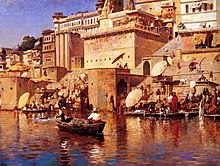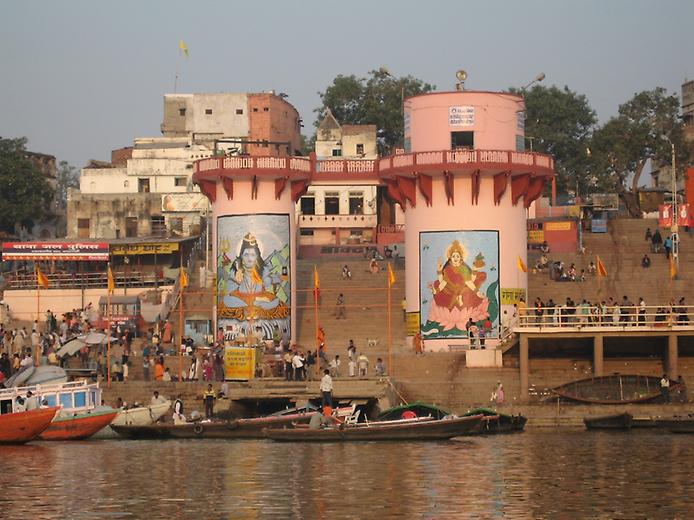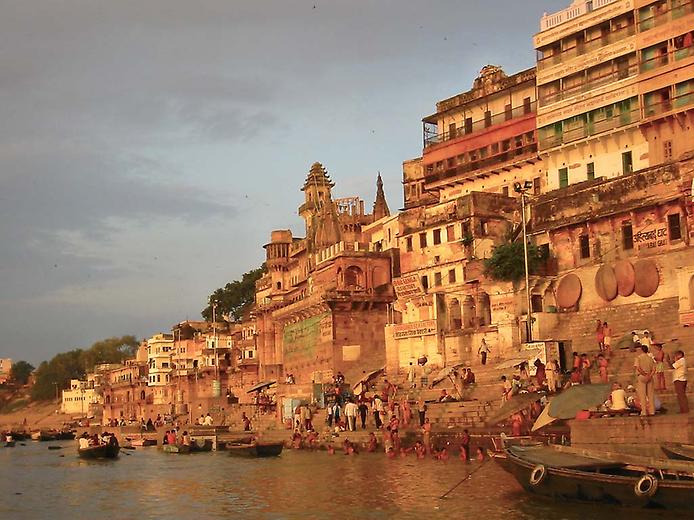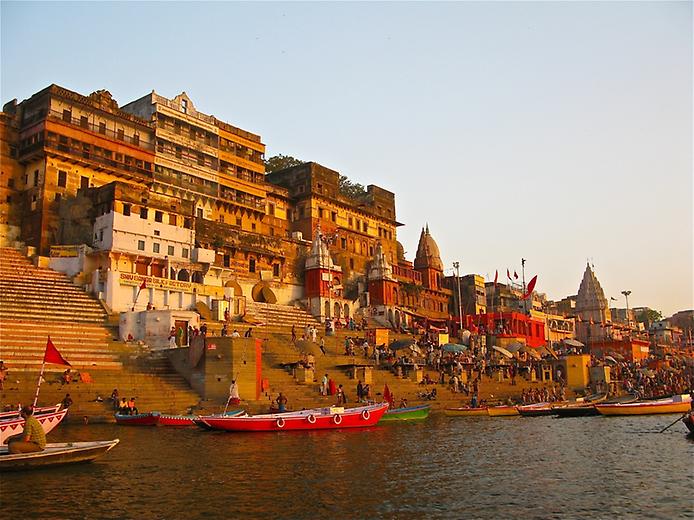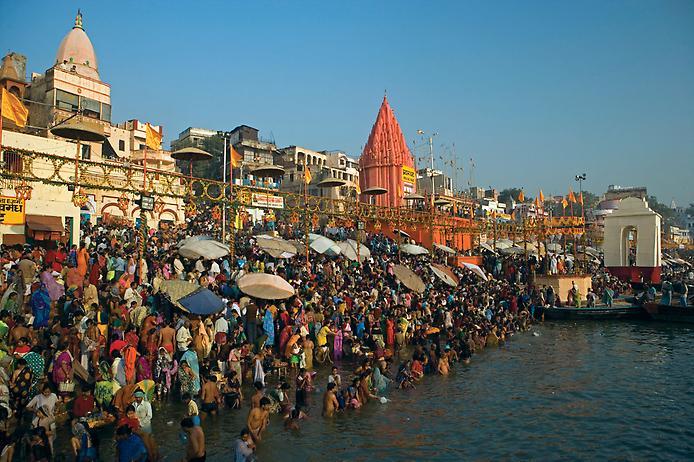Varanasi (Hindustani pronunciation: [ʋaːˈraːɳəsi] (listen)), also known as Benares, Banaras (Banāras [bəˈnaːrəs] listen)), or Kashi (Kāśī [ˈkaːʃi] (listen)), is a North Indian city on the banks of the Ganga in Uttar Pradesh, India 320 kilometres (200 mi) south-east of the state capital, Lucknow. It is the holiest of the seven sacred cities (Sapta Puri) in Hinduism and Jainism, and played an important role in the development of Buddhism. Some Hindus believe that death at Varanasi brings salvation. It is one of the oldest continuously inhabited cities in the world.Varanasi is also known as the favourite city of the Hindu deity Lord Shiva. Kashi was well known during the later Vedic period.
The Kashi Naresh (Maharaja of Kashi) is the chief cultural patron of Varanasi, and an essential part of all religious celebrations.The culture of Varanasi is closely associated with the Ganges. The city has been a cultural centre of North India for several thousand years, and has a history that is older than most of the major world religions. The Benares Gharana form of Hindustani classical music was developed in Varanasi, and many prominent Indian philosophers, poets, writers, and musicians live or have lived in Varanasi. Gautama Buddha gave his first sermon at Sarnath, located near Varanasi.
Varanasi is the spiritual capital of India. It is often referred to as "the holy city of India", "the religious capital of India", "the city of Shiva", and "the city of learning". Scholarly books have been written in the city, including the Ramcharitmanas of Tulsidas. Today, there is a temple in the city, the Tulsi Manas Mandir. The current temples and religious institutions in the city are dated to the 18th century.[10] One of the largest residential universities of Asia, the Banaras Hindu University (BHU), is located here.
Varanasi has been chosen as one of the heritage cities for HRIDAY - Heritage City Development and Augmentation Yojana scheme of the Government of IndiaThe name Varanasi possibly originates from the names of the two rivers from north and south: Varuna, still flowing in Varanasi, and Asi, a small stream near Assi Ghat. The old city does lie on the north shores of Ganges River bounded by its two tributaries Varuna and Asi.[13] Another speculation is that the city derives its name from the river Varuna, which was called Varanasi in olden times.[14] This is generally disregarded by historians. Through the ages, Varanasi has been known by many names including Kāśī or Kashi (used by pilgrims dating from Buddha's days), Kāśikā (the shining one), Avimukta ("never forsaken" by Shiva), Ānandavana (the forest of bliss), and Rudravāsa (the place where Rudra/Śiva resides).
In the Rigveda, the city is referred to as Kāśī or Kashi, the luminous city as an eminent seat of learning.[16] The name Kāśī is also mentioned in the Skanda Purana. In one verse, Shiva says, "The three worlds form one city of mine, and Kāśī is my royal palace therein."[17] The name Kashi may be translated as "City of Light".
History
Archaeological evidence of earliest known settlements around Varanasi in the Ganga valley (the seat of Vedic religion and philosophy) suggest that they began in the 11th or 12th century BC, placing it among the world's oldest continually inhabited cities These archaeological remains suggest that the Varanasi area was populated by Vedic people. However, the Atharvaveda (the oldest known text referencing the city), which dates to approximately the same period, suggests that the area was populated by indigenous tribes. It is possible that archaeological evidence of these previous inhabitants has yet to be discovered.[24] Recent excavations at Aktha and Ramnagar, two sites very near to Varanasi, show them to be from 1800 BC, suggesting Varanasi started to be inhabited by that time too.
Varanasi grew as an important industrial centre, famous for its muslin and silk fabrics, perfumes, ivory works, and sculpture.[23] During the time of Gautama Buddha (born circa 500 BCE), Varanasi was the capital of the Kingdom of Kashi.[23] The Buddha is believed to have founded Buddhism here around 528 BC when he gave his first sermon, "The Setting in Motion of the Wheel of Dharma", at nearby Sarnath.[26][27] The celebrated Chinese traveller Xuanzang, who visited the city around 635 AD, attested that the city was a centre of religious and artistic activities, and that it extended for about 5 kilometres (3.1 mi) along the western bank of the Ganges.[23][28] When Xuanzang, also known as Hiuen Tsiang, visited Varanasi in the 7th century, he named it "Polonisse" and wrote that the city had some 30 temples with about 30 monks.[29] The city's religious importance continued to grow in the 8th century, when Adi Shankara established the worship of Shiva as an official sect of Varanasiм
In ancient times, Varanasi was connected by a road starting from Taxila and ending at Pataliputra during the Mauryan Empire. In 1194, the city succumbed to Turkish Muslim rule under Qutb-ud-din Aibak, who ordered the destruction of some one thousand temples in the city.[31][32] The city went into decline over some three centuries of Muslim occupation, although new temples were erected in the 13th century after the Afghan invasion. Feroz Shah ordered further destruction of Hindu temples in the Varanasi area in 1376. The Afghan ruler Sikander Lodi continued the suppression of Hinduism in the city and destroyed most of the remaining older temples in 1496.pite the Muslim rule, Varanasi remained the centre of activity for intellectuals and theologians during the Middle Ages, which further contributed to its reputation as a cultural centre of religion and education. Several major figures of the Bhakti movement were born in Varanasi, including Kabir who was born here in 1389 and hailed as "the most outstanding of the saint-poets of Bhakti cult (devotion) and mysticism of 15th-Century India";[33] and Ravidas, a 15th-century socio-religious reformer, mystic, poet, traveller, and spiritual figure, who was born and lived in the city and employed in the tannery industry.[34] Similarly, numerous eminent scholars and preachers visited the city from across India and south Asia. Guru Nanak Dev visited Varanasi for Shivratri in 1507, a trip that played a large role in the founding of Sikhism
A Brahmin placing a garland on the holiest spot in the sacred city. A lithograph by James Prinsep, 1832.
Varanasi, 1883.
Bathing Ghat of Banaras, 1890
In the 16th century, Varanasi experienced a cultural revival under the Muslim Mughal emperor Akbar who invested in the city, and built two large temples dedicated to Shiva and Vishnu.[The Raja of Poona established the Annapurnamandir and the 200 metres (660 ft) Akbari Bridge was also completed during this period.[36] The earliest tourists began arriving in the city during the 16th century.[37] In 1665, the French traveller Jean Baptiste Tavernier described the architectural beauty of the Vindu Madhava temple on the side of the Ganges. The road infrastructure was also improved during this period and extended from Kolkata to Peshawar by Emperor Sher Shah Suri; later during the British Raj it came to be known as the famous Grand Trunk Road. In 1656, emperor Aurangzeb ordered the destruction of many temples and the building of mosques, causing the city to experience a temporary setback.] However, after Aurangazeb's death, most of India was ruled by a confederacy of pro-Hindu kings. Much of modern Varanasi was built during this time especially during the 18th century, by the Maratha and Bhumihar kings (who were rulers of Varanasi since centuries), and most of the important buildings in the city today date to this period.[38] The kings continued to be important through much of the British rule (1775–1947 AD), including the Maharaja of Benares, or Kashi Naresh. The kingdom of Benares was given official status by the Mughals in 1737, and continued as a dynasty-governed area until Indian independence in 1947, during the reign of Dr. Vibhuti Narayan Singh. In the 18th century, Muhammad Shah ordered the construction of an observatory on the Ganges, attached to Man Mandir Ghat, designed to discover imperfections in the calendar in order to revise existing astronomical tables. Tourism in the city began to flourish in the 18th century. In 1791, under the rule of the British Governor-General Warren Hastings, Jonathan Duncan founded a Sanskrit College in Varanasi. In 1867, the establishment of the Varanasi Municipal Board led to significant improvements in the city's infrastructure and basic amenities of health services, drinking water supply and sanitation
Benares riverfront, 1895
In 1897, Mark Twain, the renowned Indophile, said of Varanasi, "Benares is older than history, older than tradition, older even than legend, and looks twice as old as all of them put together. In 1910, the British made Varanasi a new Indian state, with Ramnagar as its headquarters but with no jurisdiction over the city of Varanasi itself. Kashi Naresh still resides in the Ramnagar Fort which is situated to the east of Varanasi, across the Ganges. Ramnagar Fort and its museum are the repository of the history of the kings of Varanasi. Since the 18th century, the fort has been the home of Kashi Naresh, deeply revered by the local people. He is the religious head and some devout inhabitants consider him to be the incarnation of Shiva. He is also the chief cultural patron and an essential part of all religious celebrations.




